April 24, 2025
Two days after the Jones road fire started. My feet make puffs of ash as I walk through the woods. There are little pillars of smoke smoldering but the fire is mostly out- here. I heard reports that it’s still active in other areas. When I catch mice at home I release them in the woods and I wanted to check on the area. When I got to my release spot I was saddened to see that it was burned but hopeful that they made it across the street - where the forest was untouched. In the same area I encountered news crew commenting on the smoldering trees worried that they would fall on them. We talked about the fire roads that help divide up the forest to keep fires under control. It seemed ineffective. I was looking for a shot of a bird on some burnt trees. It’s a sad thing. On the way out I saw some deer and one looked over its shoulder. Its face conveyed the emotion.
April 5, 2025
Volunteering for NJ wildlife at lake Shenandoah for the trout count 2025. I was surprised at the water level in the lake. Not seeing any anglers, low water levels, and looming rain made for a gloomy start. But after a little wandering and meeting some locals I learned where all the trout were. All I had to do was follow the osprey. The osprey found that all the trout were downstream past the spillway construction. Finding a great spot to get a shot I only had wait long enough to set the focus and exposer, and then was suddenly surprised that an osprey splashed into my frame! Easiest shot ever! It began raining shortly after but I left quite happy.
April 4, 2025
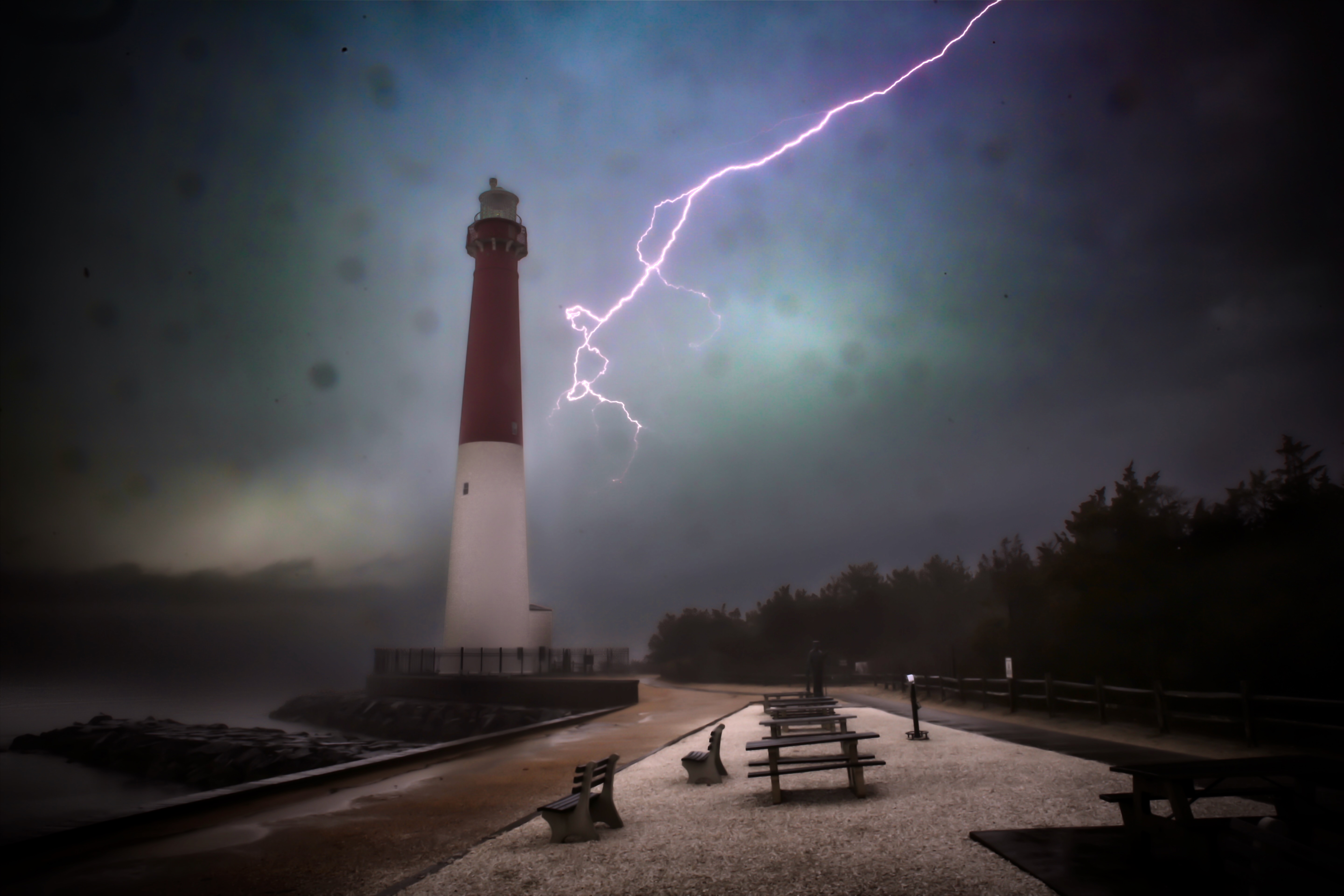
Storm chasing. Initial weather reports called for such a low chance of thunder storms that I hadn’t given going out much thought. But, during my morning meditation I saw so much lighting that I decided that I was perhaps wrong. Grabbing my camera I checked the weather report and ran out the door to Barnegat Light to see if I could catch the tail end of the front. And I missed most of it except for a straggler that turned the sky dark and air cold. I saw one bolt of lightning next to the lighthouse and was glad to have gotten a shot of it. There was green skies, fog on the bay, lighting, and a beautiful day afterwards.
April 2, 2025
Look at those wings. An egret flies towards me to get a better position to fish. I was surprised and wished that I had a camera with a quicker auto focus. Every time I see this bird I wonder at its coloring or lack thereof. How does such a creature come to be? In a land of camouflage this one stands out and look at those wings.
March 28, 2025
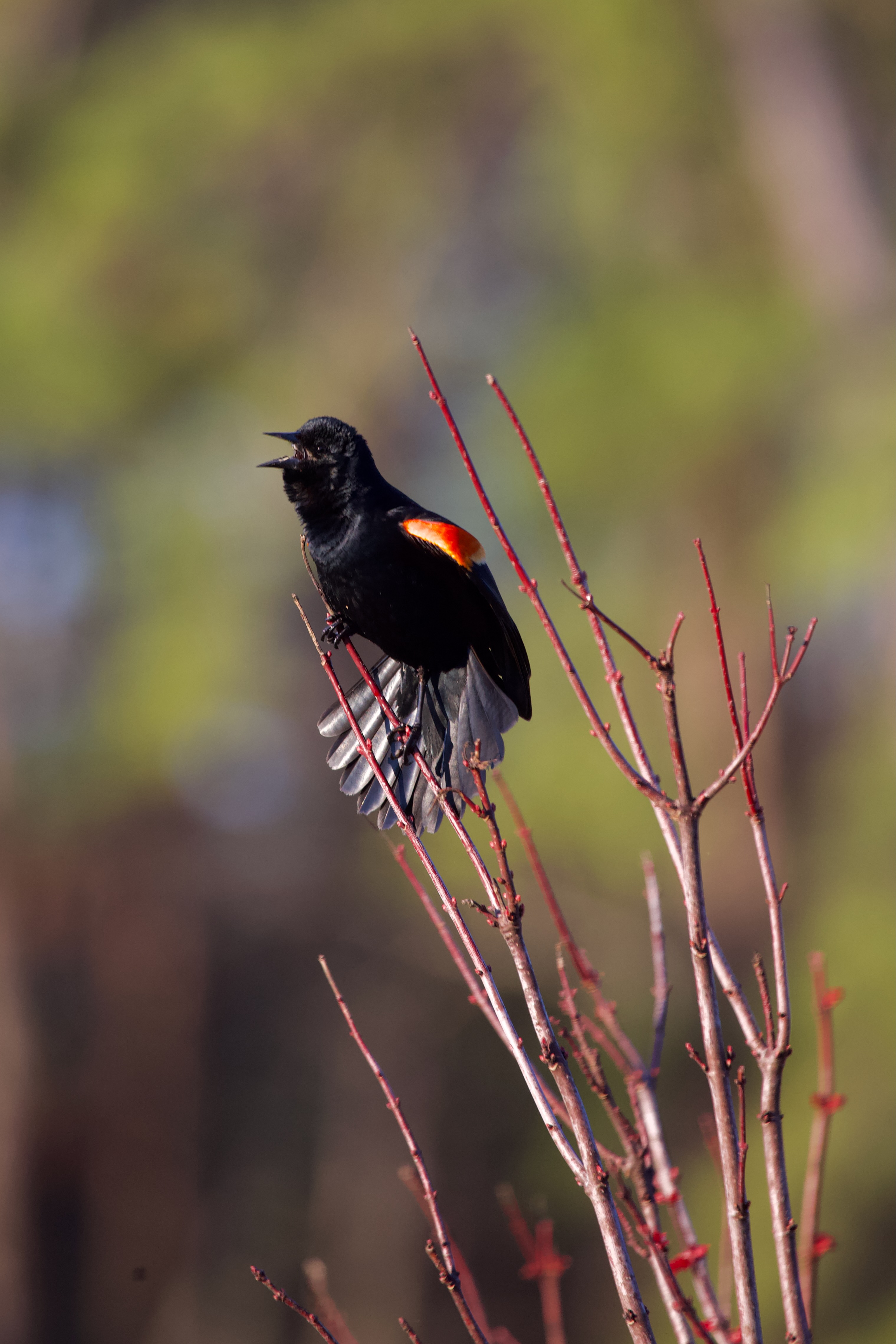
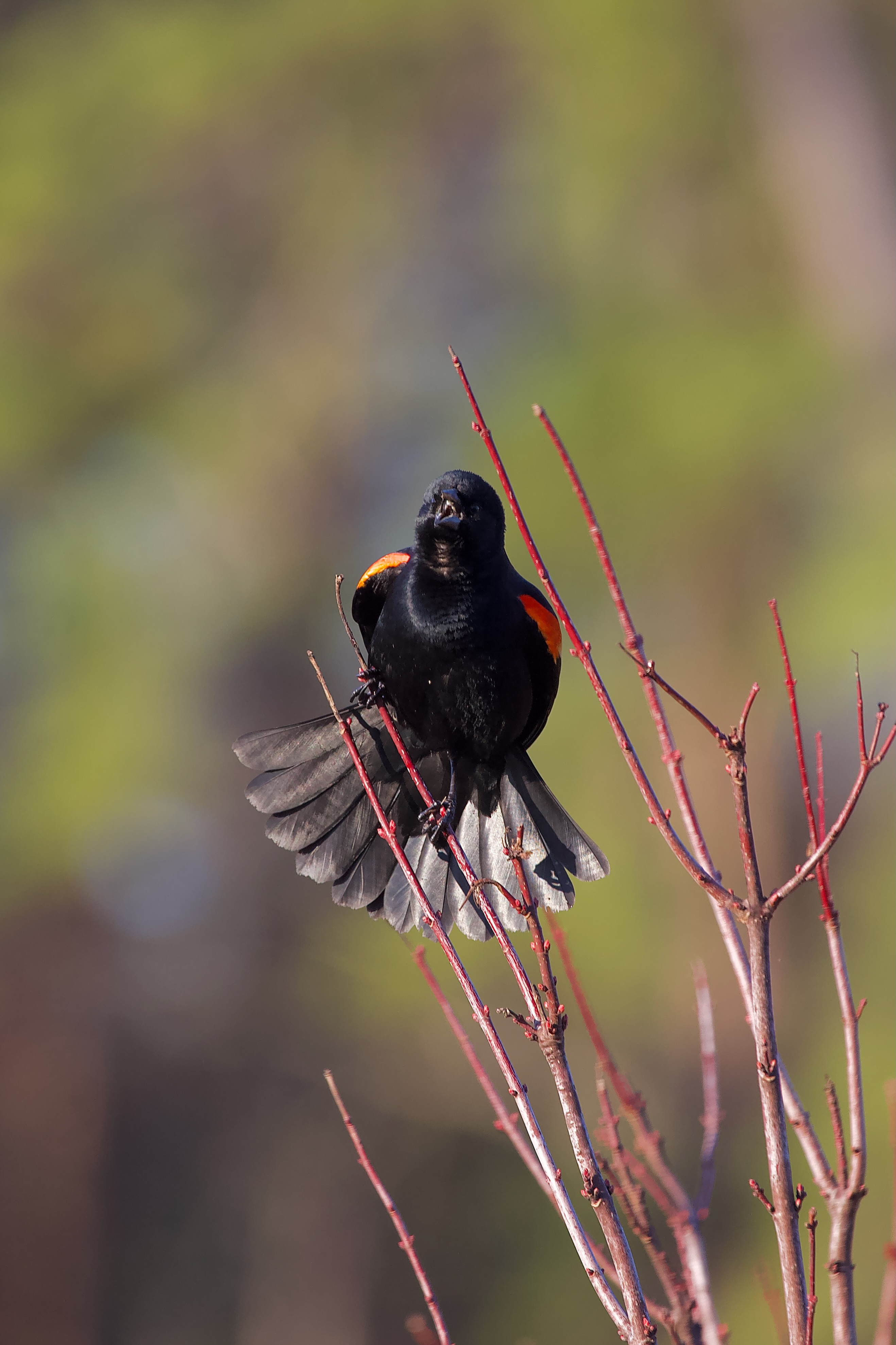
Say ah! I finally captured a good shot of a Red-winged Blackbird—and to my surprise, when I reviewed the photos at home, I could see right into the back of its throat! With the return of the blackbirds to the area, it’s clear that spring has arrived. The migrations are in full swing, and a seasonal highpoint is on the horizon. The morning was alive with activity. Every bird seemed to be out shopping for the best local insects to eat. As I wandered, I noticed a particular section of woods teeming with avian visitors. A local guru pointed out the secret: the sun hits those trees first, warming the bark and stirring the insects earlier than in the surrounding areas—a natural breakfast buffet for the birds. I had assumed they were simply drawn to the warmth, but it turns out they were following the food. Among the chorus of birdsong, the cowbirds’ flock calls stood out. Their strange, metallic notes sounded like little computers dropping wooden tokens—a mechanical rhythm blending into the woodland symphony.
March 5, 2025

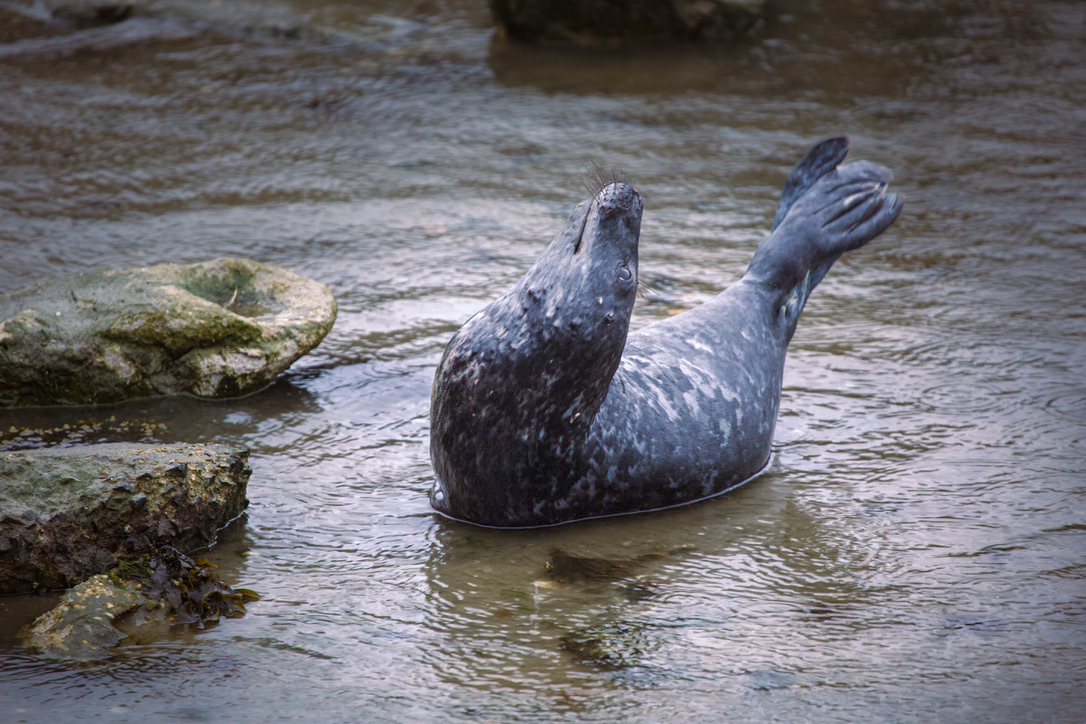
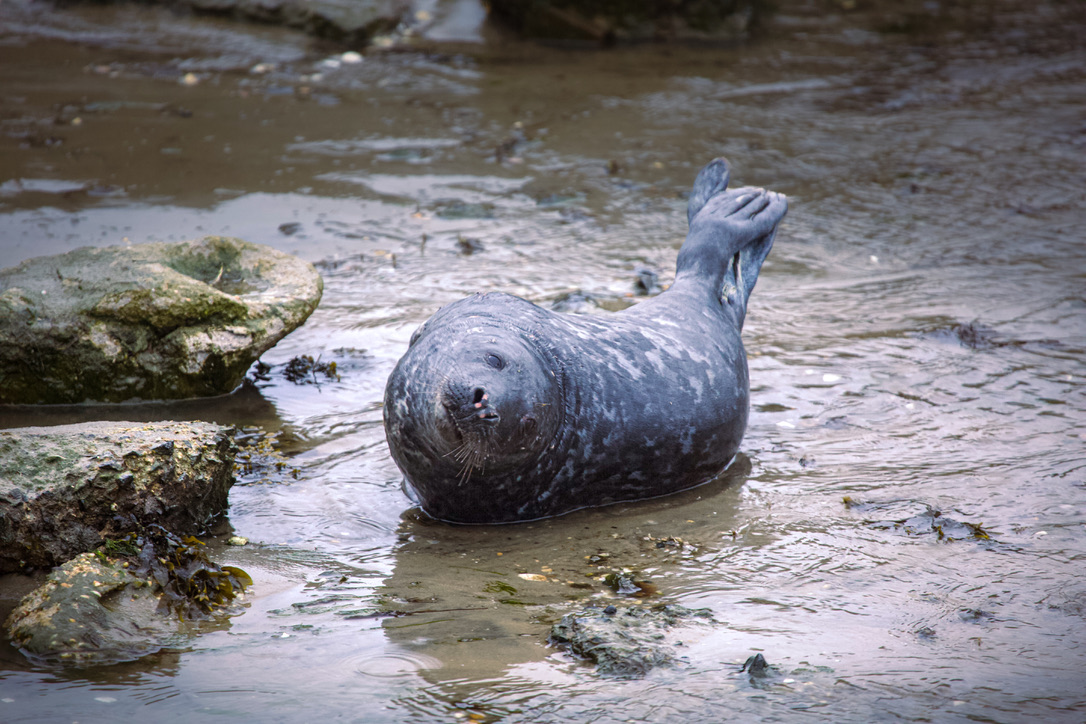
In an effort to capture photographs of an approaching storm, I ventured to Barnegat Light, seeking shelter and awaiting the perfect moment. After hours of relentless rain and diminishing hopes for lightning, a seagull caught my attention, repeatedly diving for prey. Seizing the opportunity, I switched lenses, protected my camera with a rain cover, and approached to capture the action. To my astonishment, a seal lay basking in the rain, mere feet from my position. As the sun set amidst the downpour, I steadied my 400mm lens and captured the seal's serene expression smiling in the rain, a testament to its comfort in any weather. According to save coastal wildlife NJ, Seals are a common sight along the New Jersey coastline, especially during the colder months. The most frequently observed species is the harbor seal (Phoca vitulina), characterized by its rounded head and V-shaped nostrils. These seals typically measure between 5 to 6 feet in length and can weigh up to 300 pounds. They migrate from northern breeding grounds to New Jersey's shores, arriving in December and departing by April. savecoastalwildlife.org
February 26, 2025
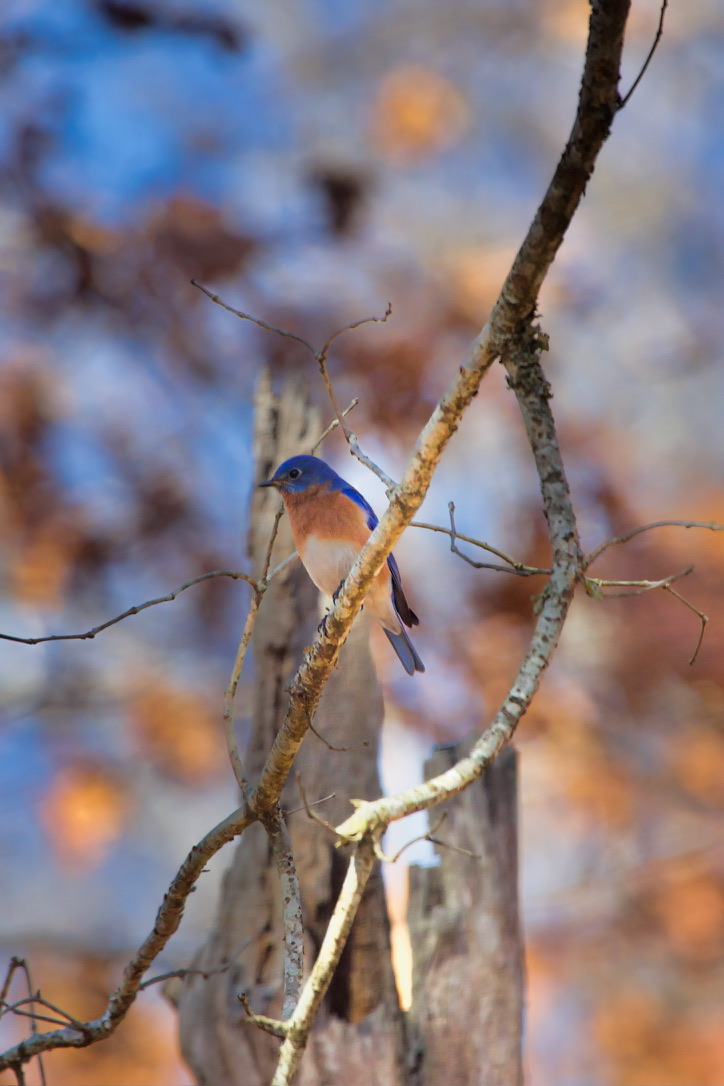
By heavens, what a splendid day! The warmest yet of the year, and with it, the stirring of life returning to the land. As I strode through the woods, the good fortune of the day revealed itself—a fine bluebird perched before a sturdy old tree stump, his feathers flashing like a bit of sky fallen to earth. The sun, in its full and righteous glory, poured its warmth upon us, stirring the creatures of the land to action. Along the way, I encountered old friends—some of the two-legged variety, others winged and wild—all drawn forth by the promise of spring’s eventual return. There is a particular satisfaction in such days, when the air hums with vigor, and every living thing seems to understand that it is good to be alive.
February 20, 2025
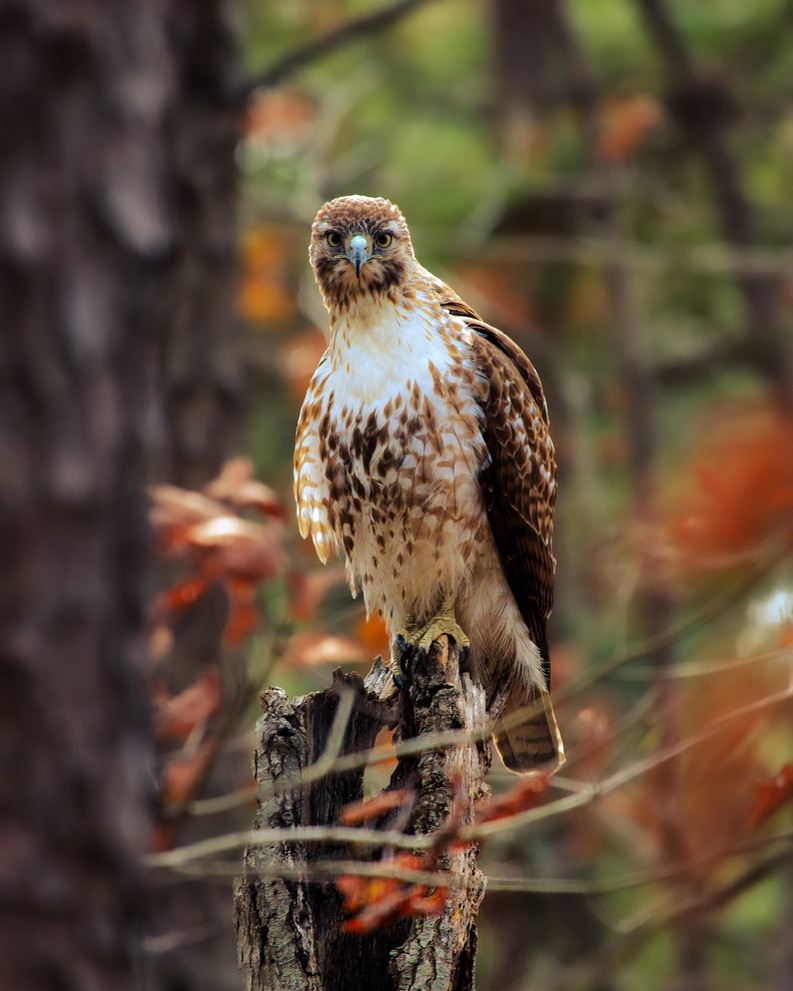
After weeks of not seeing much in the wild, due in part, to what I think was warmer temps then in January, I finally saw something during my daily walk in the wild. Like January, the temperatures are in the teens at night and early morning. I believe, since I’m no biologist, an increase of activity during noontime is necessary since it obviously too cold for breakfast. My walk was brisk like the air and I struggled to keep my head up to look around while keeping a brisk pace. But, just as I looked up I saw this Red Tail hawk in mid groom staring at me. Sorry! The hawk sat patiently for a moment while I fumbled with my glove to grip the camera and I fired off a couple of snaps. It’d been a month since a decent photograph. I’d never experienced such a dry spell. Hopefully this weekend will bring some more opportunities.
January 20, 2025
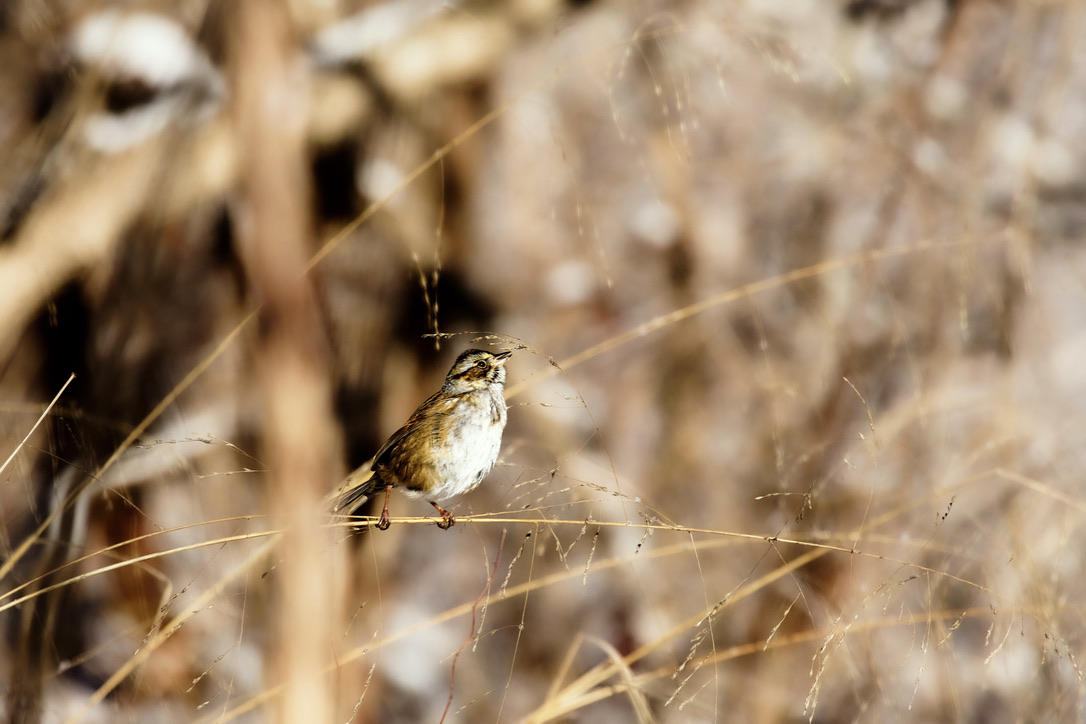

 This morning, with temperatures in the teens, I ventured into the fourth snowfall of the year, testing cold-weather gear in the hope of keeping frostbite at bay. Previous snowy excursions had left my hands and feet aching, but today, the gear held up as nature offered its quiet winter spectacle.
In the crisp, breezeless chill of early morning, a swamp sparrow caught my eye. Balancing ever so gently, it reached for grass seed glistening in the sunlight—in contrast I stood in the shade of the field using my monopod to control camera shake and trying not to freeze. Not far away, a true rockstar made her appearance: a kingfisher, perched with poise. She sang her fishing anthem, each note cutting through the stillness, while striking poses as if fully aware of her status as the star of the show. Thankfully the ice melted enough for her to catch a meal.
This morning, with temperatures in the teens, I ventured into the fourth snowfall of the year, testing cold-weather gear in the hope of keeping frostbite at bay. Previous snowy excursions had left my hands and feet aching, but today, the gear held up as nature offered its quiet winter spectacle.
In the crisp, breezeless chill of early morning, a swamp sparrow caught my eye. Balancing ever so gently, it reached for grass seed glistening in the sunlight—in contrast I stood in the shade of the field using my monopod to control camera shake and trying not to freeze. Not far away, a true rockstar made her appearance: a kingfisher, perched with poise. She sang her fishing anthem, each note cutting through the stillness, while striking poses as if fully aware of her status as the star of the show. Thankfully the ice melted enough for her to catch a meal.
January 17, 2025
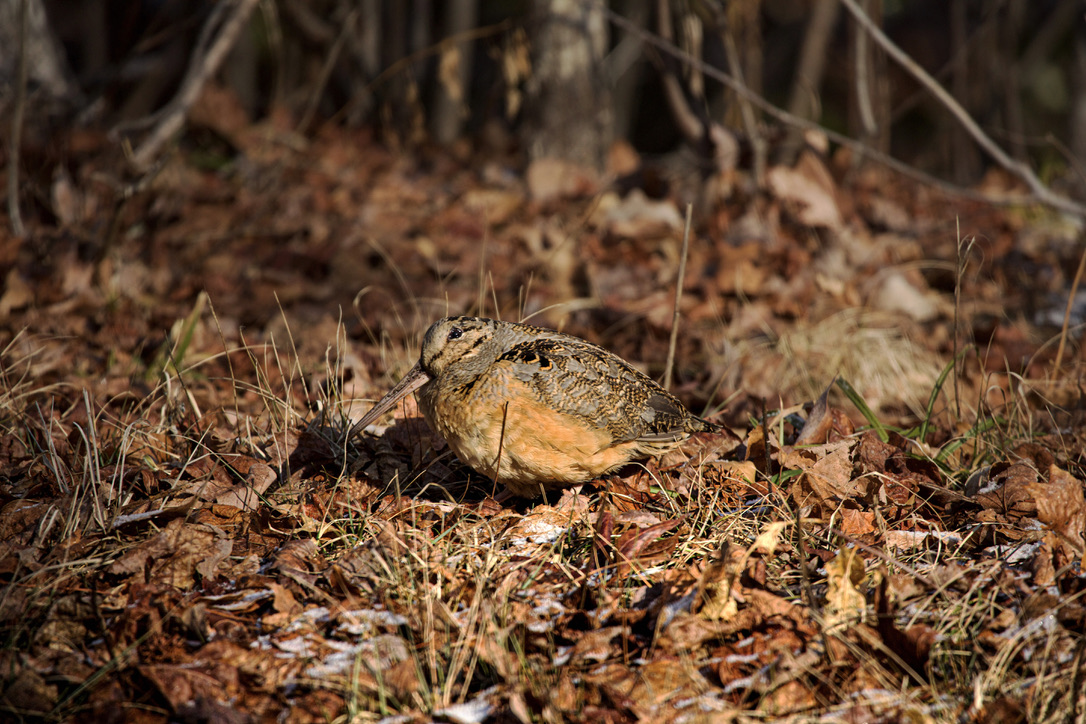
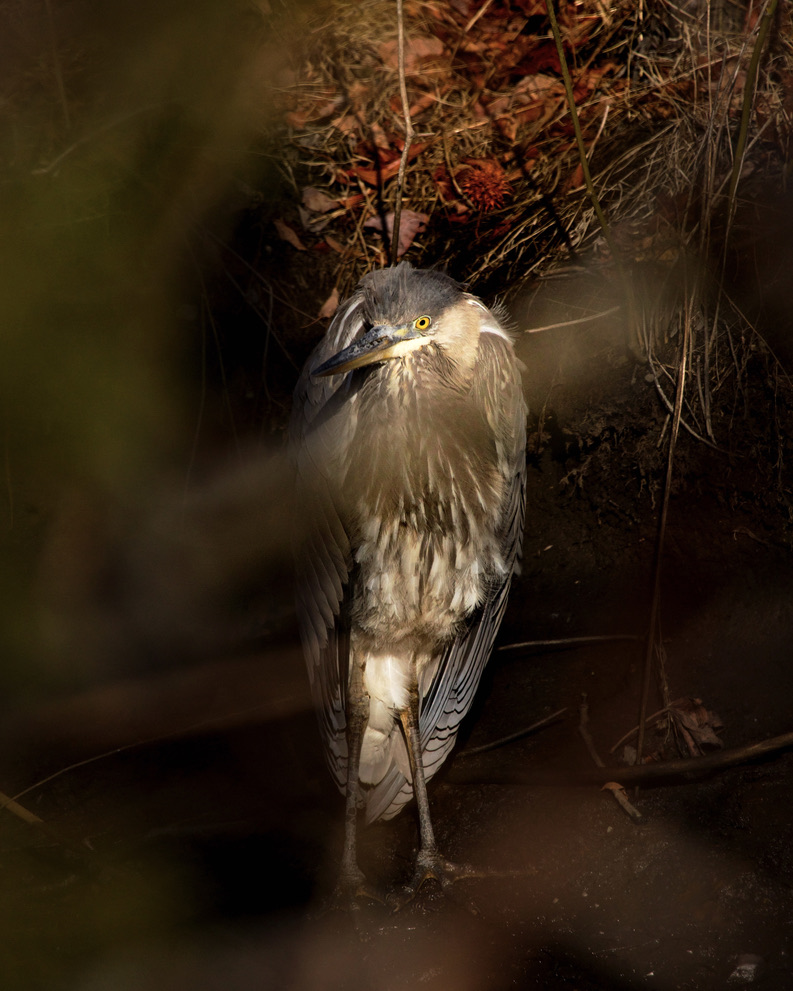 Snowfall Discovery: The Enchanting Dance of the American Woodcock
The third snowfall of the new year blanketed the Manahawkin Conservation Area in serene white. As I wandered through the trails alongside the NJ Fish and Wildlife Department, I hoped for a glimpse of something extraordinary. Hours passed with little luck, but patience paid off when the snow-covered silence was broken by two remarkable moments.
First, a Blue Heron posed as if it knew where the key-light was , its elegant form was perfectly framed by a spotlight of sun. Then, just nearby, a delightful surprise: an American Woodcock, a bird I had never seen before.
The woodcock’s dance was mesmerizing—an almost comical yet fascinating display. With a rocking motion, it bobbed back and forth, shifting its weight from one leg to the other. Some say this behavior is a clever technique to stir the ground to coax worms to the surface. Its long, slender bill probed the soil with rhythmic precision, retrieving its prize from beneath the snow.
Snowfall Discovery: The Enchanting Dance of the American Woodcock
The third snowfall of the new year blanketed the Manahawkin Conservation Area in serene white. As I wandered through the trails alongside the NJ Fish and Wildlife Department, I hoped for a glimpse of something extraordinary. Hours passed with little luck, but patience paid off when the snow-covered silence was broken by two remarkable moments.
First, a Blue Heron posed as if it knew where the key-light was , its elegant form was perfectly framed by a spotlight of sun. Then, just nearby, a delightful surprise: an American Woodcock, a bird I had never seen before.
The woodcock’s dance was mesmerizing—an almost comical yet fascinating display. With a rocking motion, it bobbed back and forth, shifting its weight from one leg to the other. Some say this behavior is a clever technique to stir the ground to coax worms to the surface. Its long, slender bill probed the soil with rhythmic precision, retrieving its prize from beneath the snow.
January 15, 2025
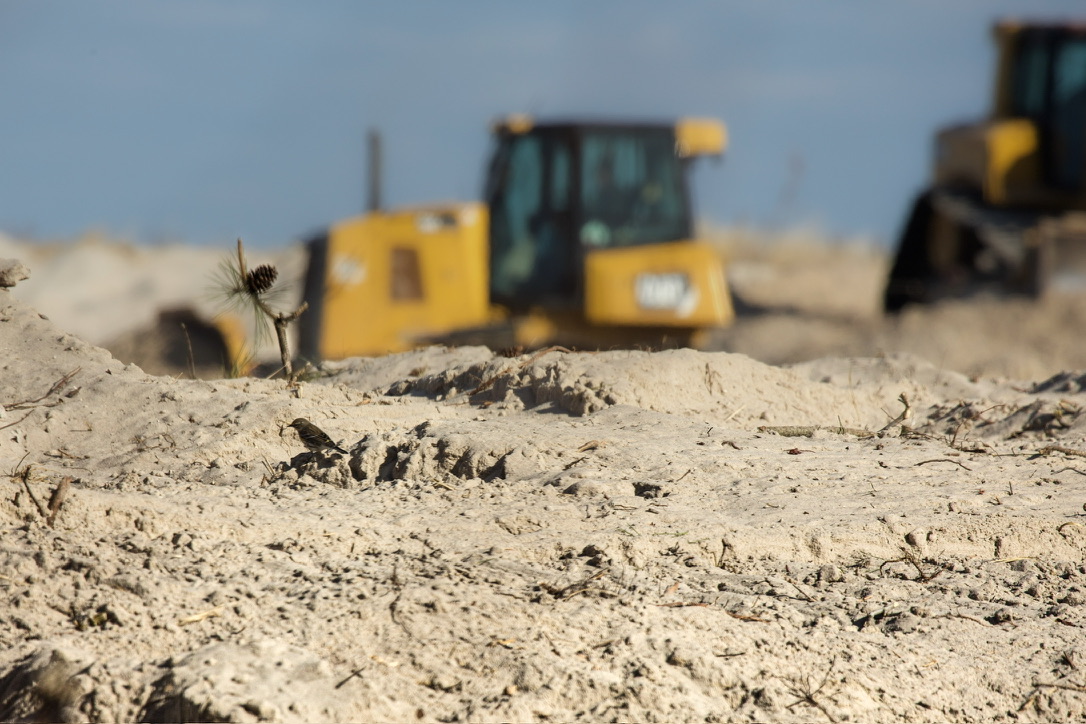
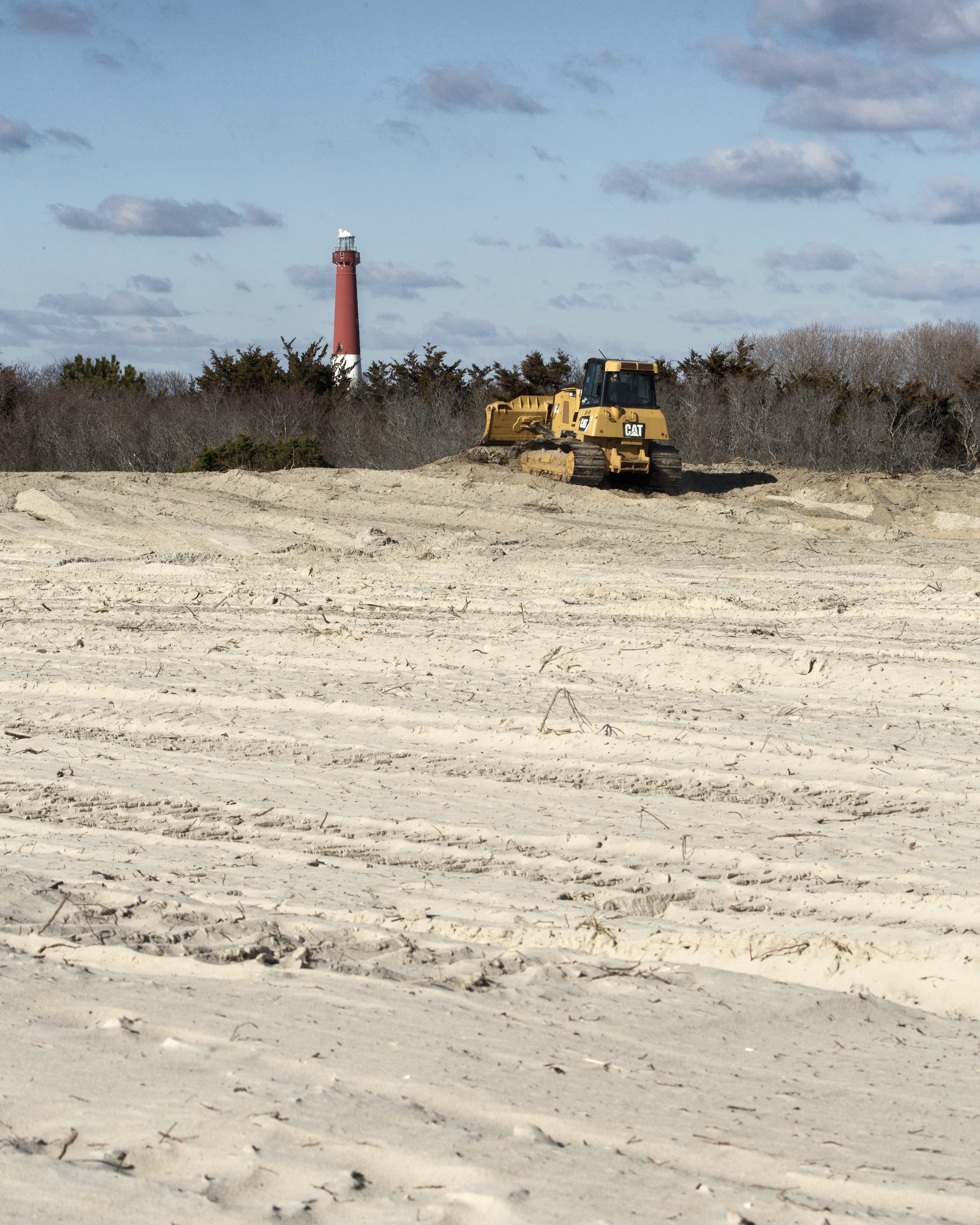
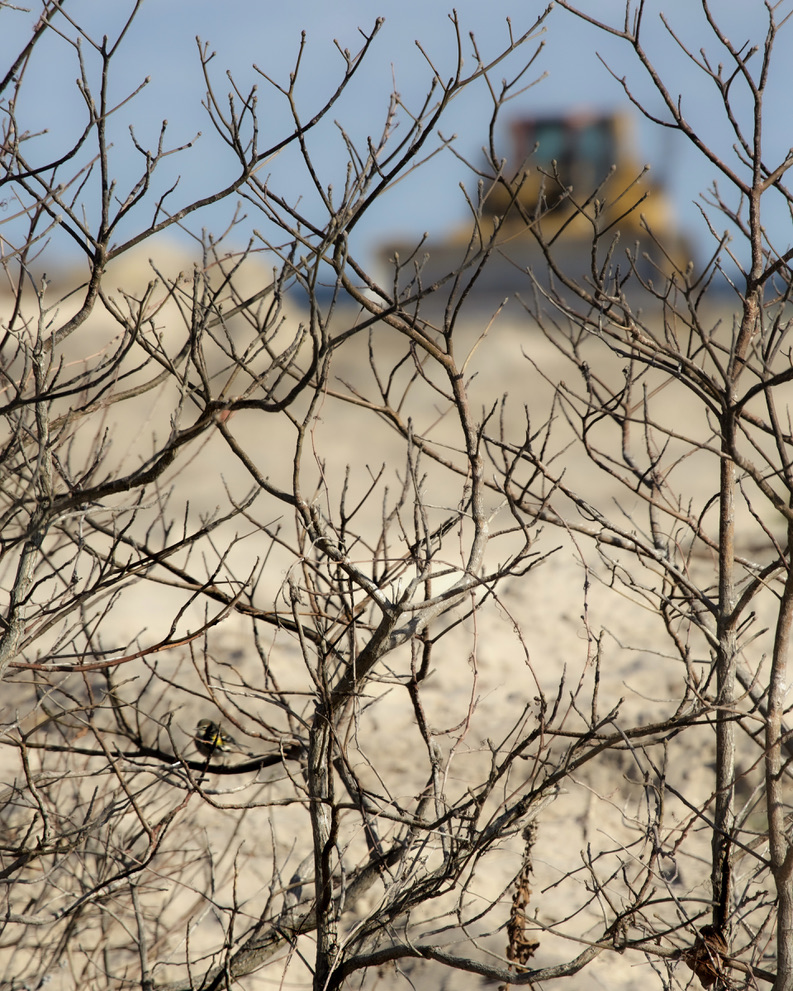
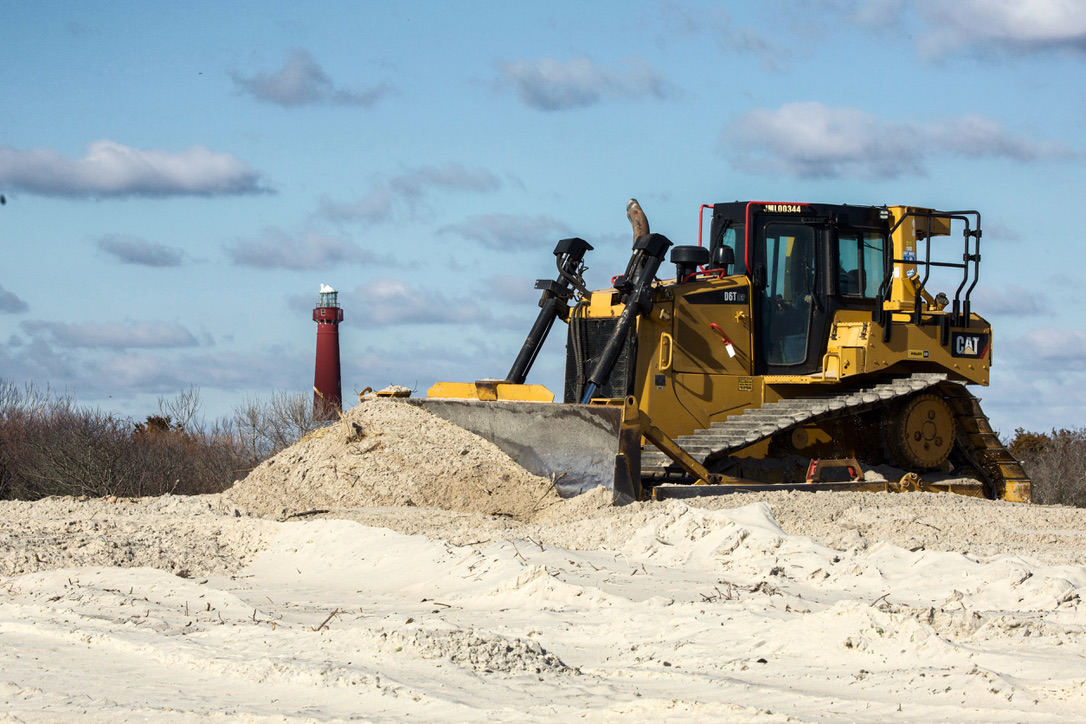 While photographing birds at Barnegat Light, I met Todd Pover, a biologist working on a unique conservation project with the Conserve Wildlife Foundation. Two bulldozers rumbled across the dunes, and it was clear this wasn’t ordinary construction. Mr. Pover explained that they were imitating a natural disaster—an inexpensive yet effective method to create nesting habitats for shorebirds.
The process is a balancing act. To create new, more necessary habitats, existing ones must sometimes be destroyed. Mr. Pover described how they analyze bird counts, habitat areas, and available resources to make these tough decisions. The goal is always the same: to ensure the survival of species that depend on these environments.
By this spring, the reshaped dunes will be ready to welcome migrating birds, providing a fresh start for frontier species drawn to these new habitats. This project is just one example of how carefully planned habitat destruction can pave the way for stronger, more sustainable ecosystems.
While photographing birds at Barnegat Light, I met Todd Pover, a biologist working on a unique conservation project with the Conserve Wildlife Foundation. Two bulldozers rumbled across the dunes, and it was clear this wasn’t ordinary construction. Mr. Pover explained that they were imitating a natural disaster—an inexpensive yet effective method to create nesting habitats for shorebirds.
The process is a balancing act. To create new, more necessary habitats, existing ones must sometimes be destroyed. Mr. Pover described how they analyze bird counts, habitat areas, and available resources to make these tough decisions. The goal is always the same: to ensure the survival of species that depend on these environments.
By this spring, the reshaped dunes will be ready to welcome migrating birds, providing a fresh start for frontier species drawn to these new habitats. This project is just one example of how carefully planned habitat destruction can pave the way for stronger, more sustainable ecosystems.
January 11, 2025
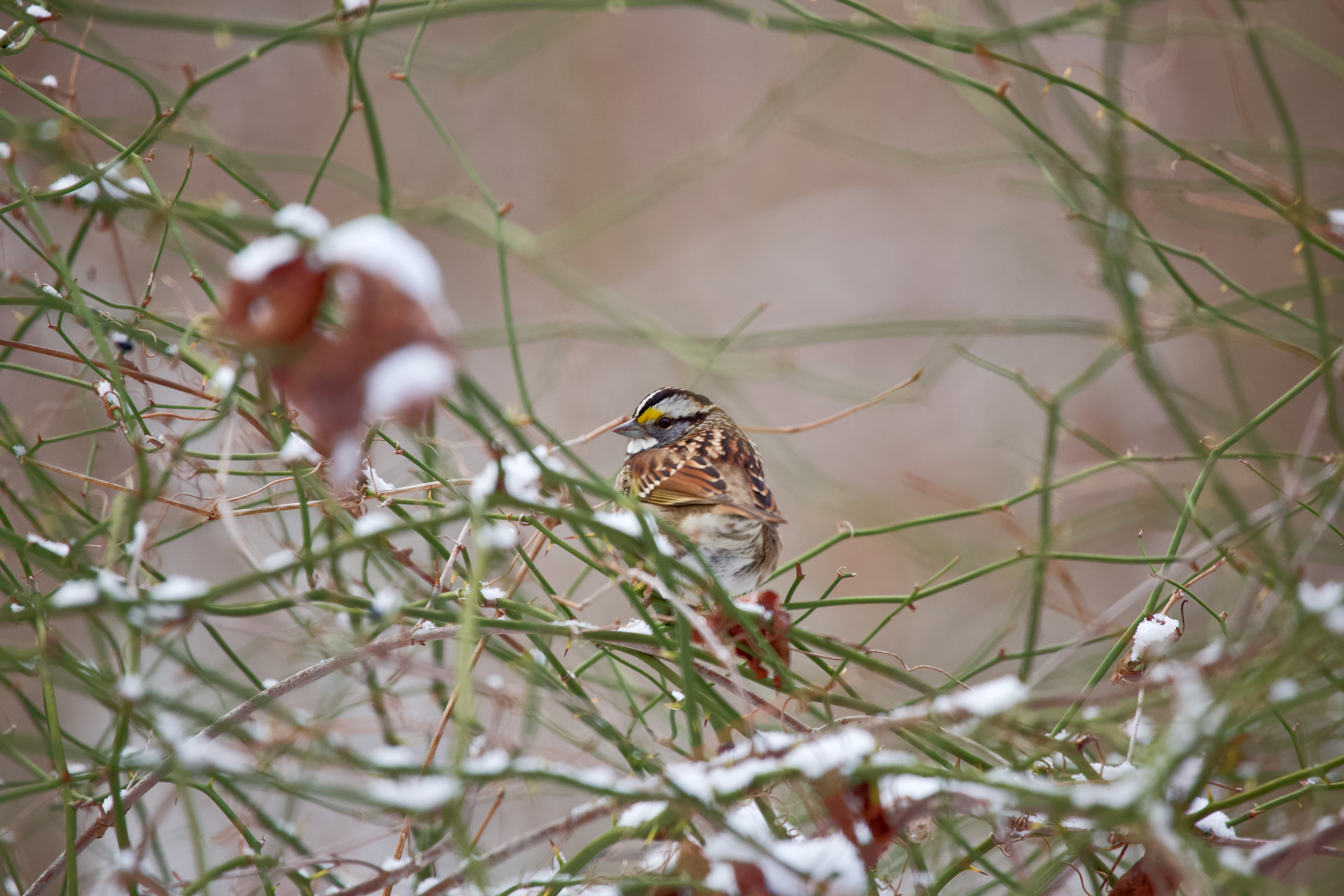
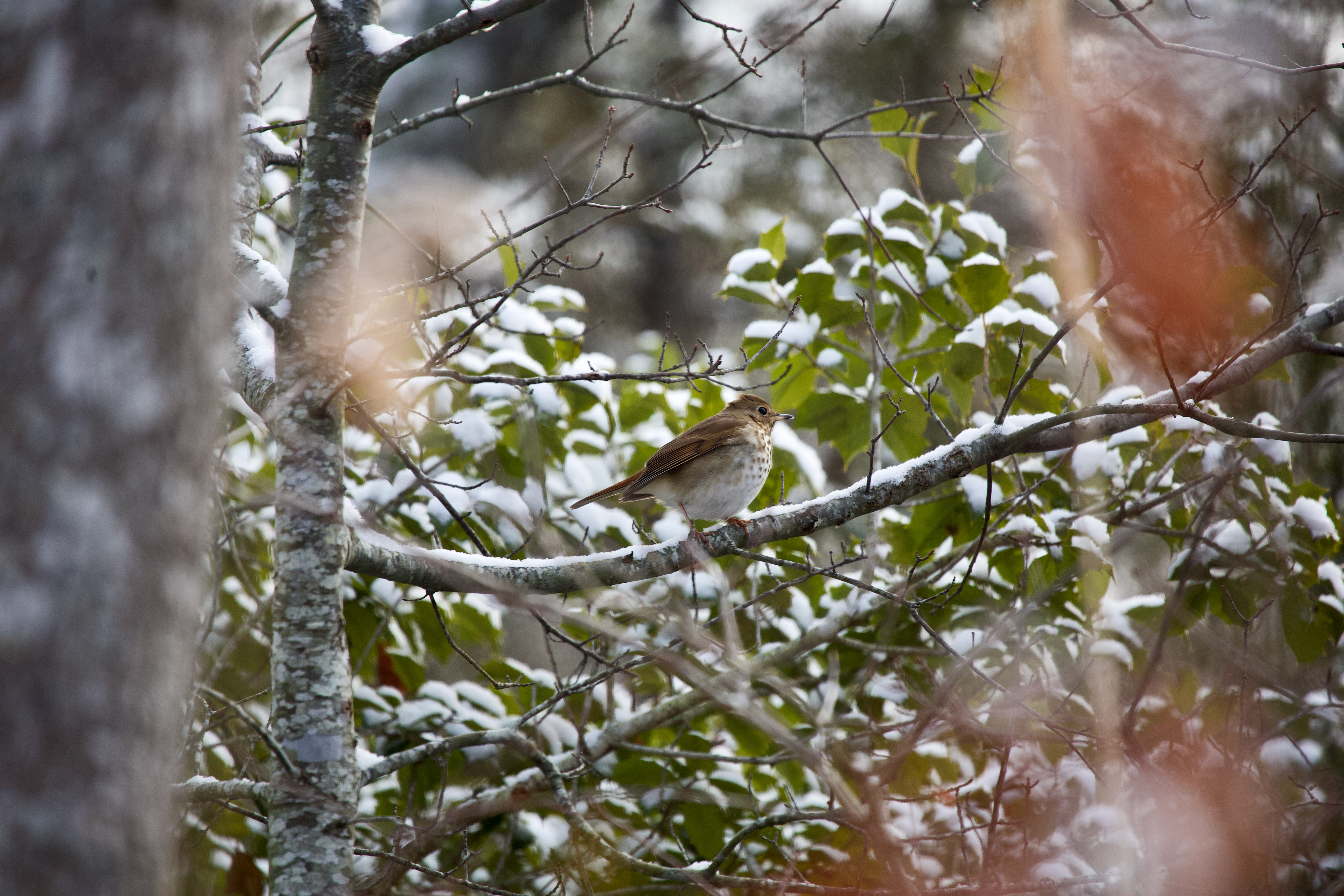
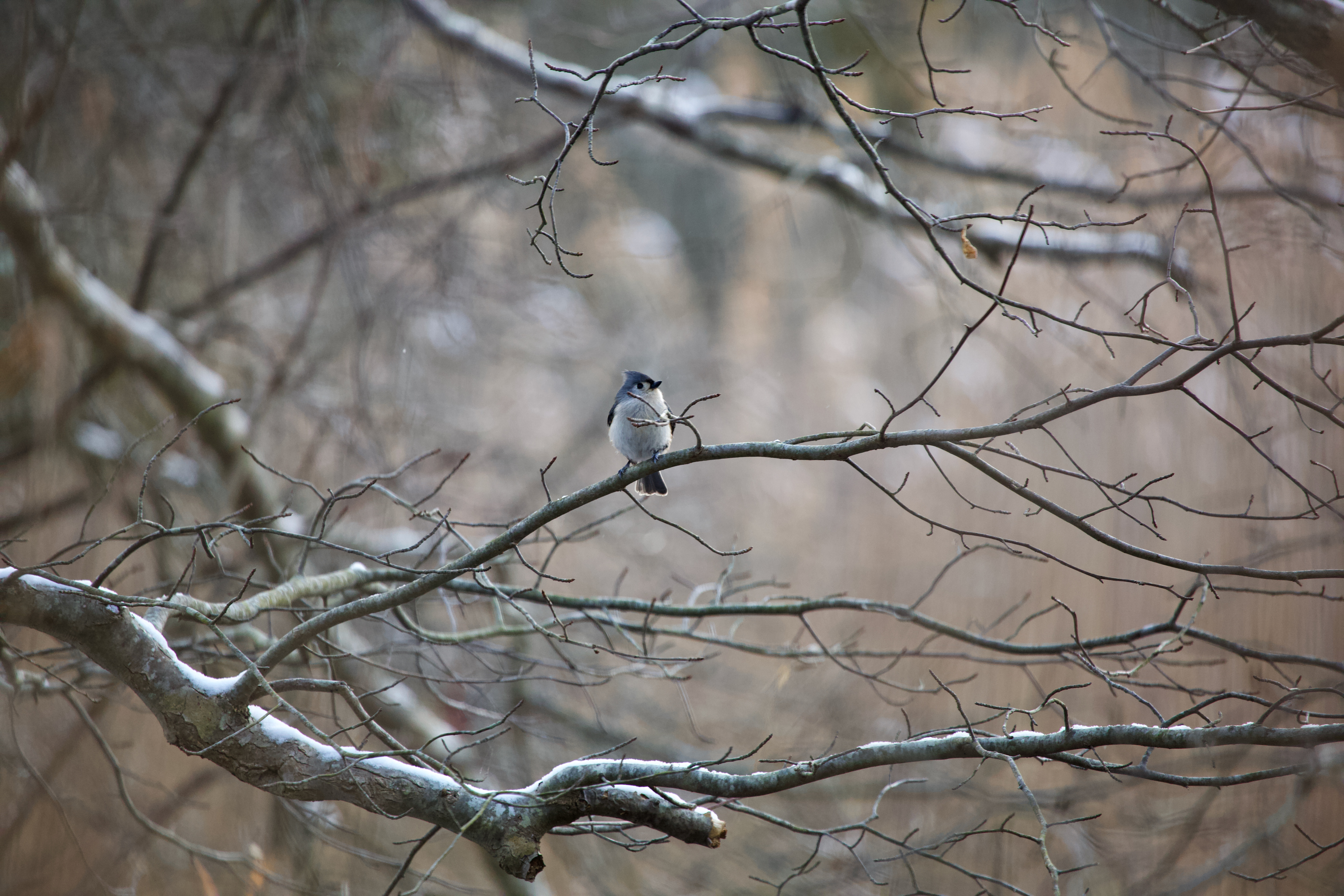
 January 11, 2025
The second snowfall of the year brought a softer, warmer touch to the landscape. Drawn by the promise of activity in the marshes, I ventured out, camera in hand, hoping to glimpse birds in the snow. Unlike the previous snow, where the cold seemed to still everything, the warmer air this time had roused the wildlife.
Birds flitted across the marshes, their energy a sharp contrast to the serene white ground. Amid the familiar sights and sounds, one moment stood out—a young night heron, a bird I had never seen before. Its presence felt like a gift from the marsh, a rare treasure revealed by the gentle snowfall.
The marsh in winter is a place of quiet transformation, where even the most subtle changes in weather can awaken a new chapter of life. This day, with its snowfall and lively birds, was a reminder of the beauty and discovery that waits in every season.
January 11, 2025
The second snowfall of the year brought a softer, warmer touch to the landscape. Drawn by the promise of activity in the marshes, I ventured out, camera in hand, hoping to glimpse birds in the snow. Unlike the previous snow, where the cold seemed to still everything, the warmer air this time had roused the wildlife.
Birds flitted across the marshes, their energy a sharp contrast to the serene white ground. Amid the familiar sights and sounds, one moment stood out—a young night heron, a bird I had never seen before. Its presence felt like a gift from the marsh, a rare treasure revealed by the gentle snowfall.
The marsh in winter is a place of quiet transformation, where even the most subtle changes in weather can awaken a new chapter of life. This day, with its snowfall and lively birds, was a reminder of the beauty and discovery that waits in every season.
January 10, 2025
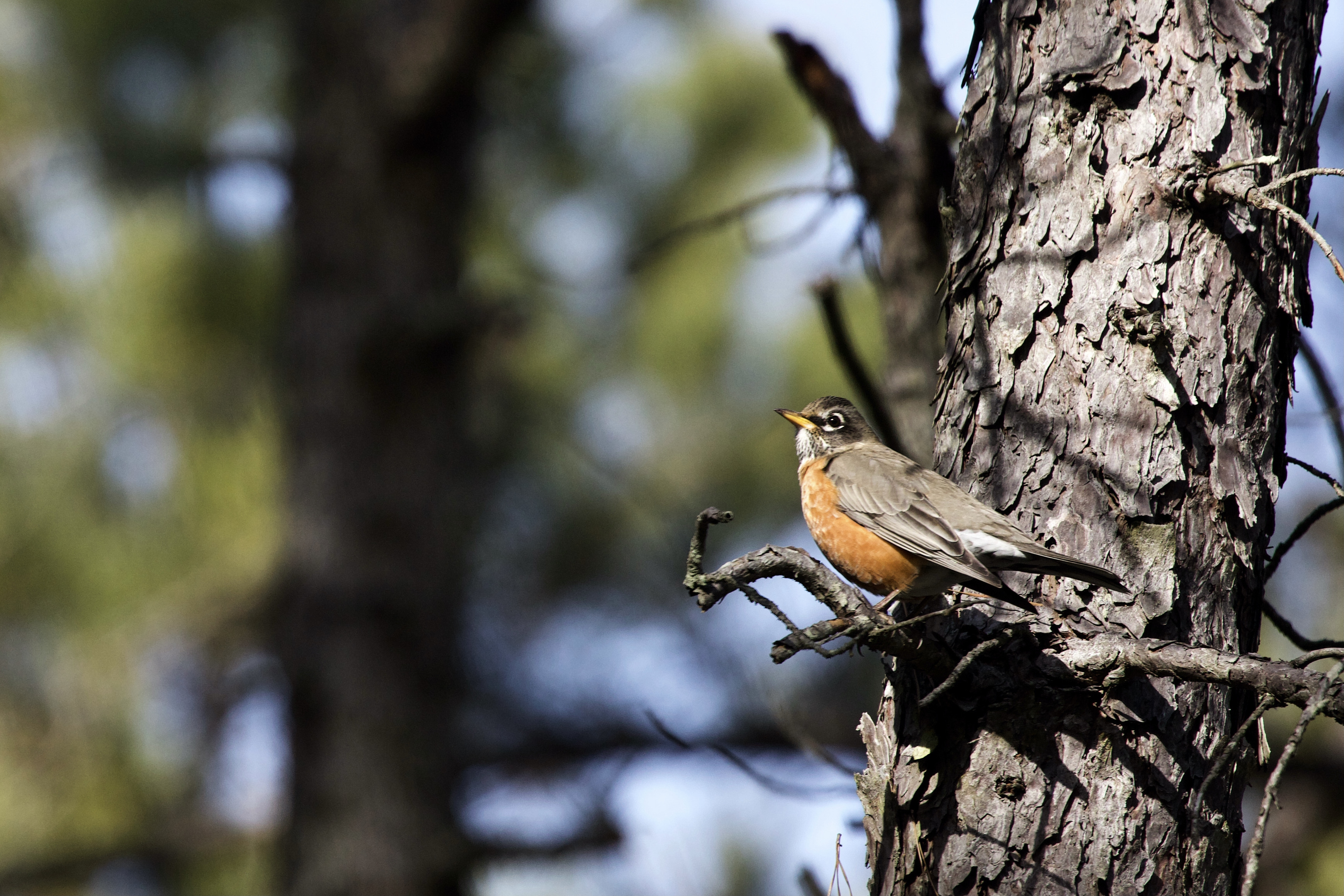 January 10, 2025
Sometimes, the most common things shine with the greatest beauty. A robin perched in a pine tree—unassuming, familiar, yet utterly magnificent in its simplicity.
The bird’s vibrant red breast contrasted with the deep green needles, a quiet burst of color against the winter stillness. It sat motionless for a moment, as though contemplating the world, or perhaps just enjoying its place within it. The pine swayed gently in the breeze, and the robin seemed a natural extension of the tree itself—a perfect harmony between bird and branch. There’s a unique magic in these quiet moments: no grandeur, no spectacle, just the profound elegance of life as it is. A robin in a pine tree—a reminder that beauty often lies in what we see every day, waiting for us to pause and notice.
January 10, 2025
Sometimes, the most common things shine with the greatest beauty. A robin perched in a pine tree—unassuming, familiar, yet utterly magnificent in its simplicity.
The bird’s vibrant red breast contrasted with the deep green needles, a quiet burst of color against the winter stillness. It sat motionless for a moment, as though contemplating the world, or perhaps just enjoying its place within it. The pine swayed gently in the breeze, and the robin seemed a natural extension of the tree itself—a perfect harmony between bird and branch. There’s a unique magic in these quiet moments: no grandeur, no spectacle, just the profound elegance of life as it is. A robin in a pine tree—a reminder that beauty often lies in what we see every day, waiting for us to pause and notice.
January 9, 2025
In the windy, biting cold of a 26-degree morning at Cloverdale Farm Park, a golden-crowned kinglet performed its delicate winter dance. Against a backdrop of bare branches and gusty winds, this tiny jewel flitted joyfully, a bright flash of gold against the muted tones of the season.
The kinglet darted from branch to branch, searching intently for food around lichen. Its movements were whimsical, as though it were engaged in a celebratory rite of winter. With wings loose and fluttering, it swayed and spun in the wind, resembling a leaf caught in a playful breeze. At times, it clung to a branch with just one leg, its lithe posture a blend of elegance and adaptability, perhaps a clever way to mimic its surroundings.
As my fingers began to freeze this moment felt less like a struggle and more like a joyous expression of life in the heart of winter. The kinglet's dance was a reminder of nature's ability to turn even the harshest conditions into a scene of quiet beauty. Observing its graceful performance was like witnessing the season's spirit embodied—a winter rite, fleeting yet profound.
January 8, 2025
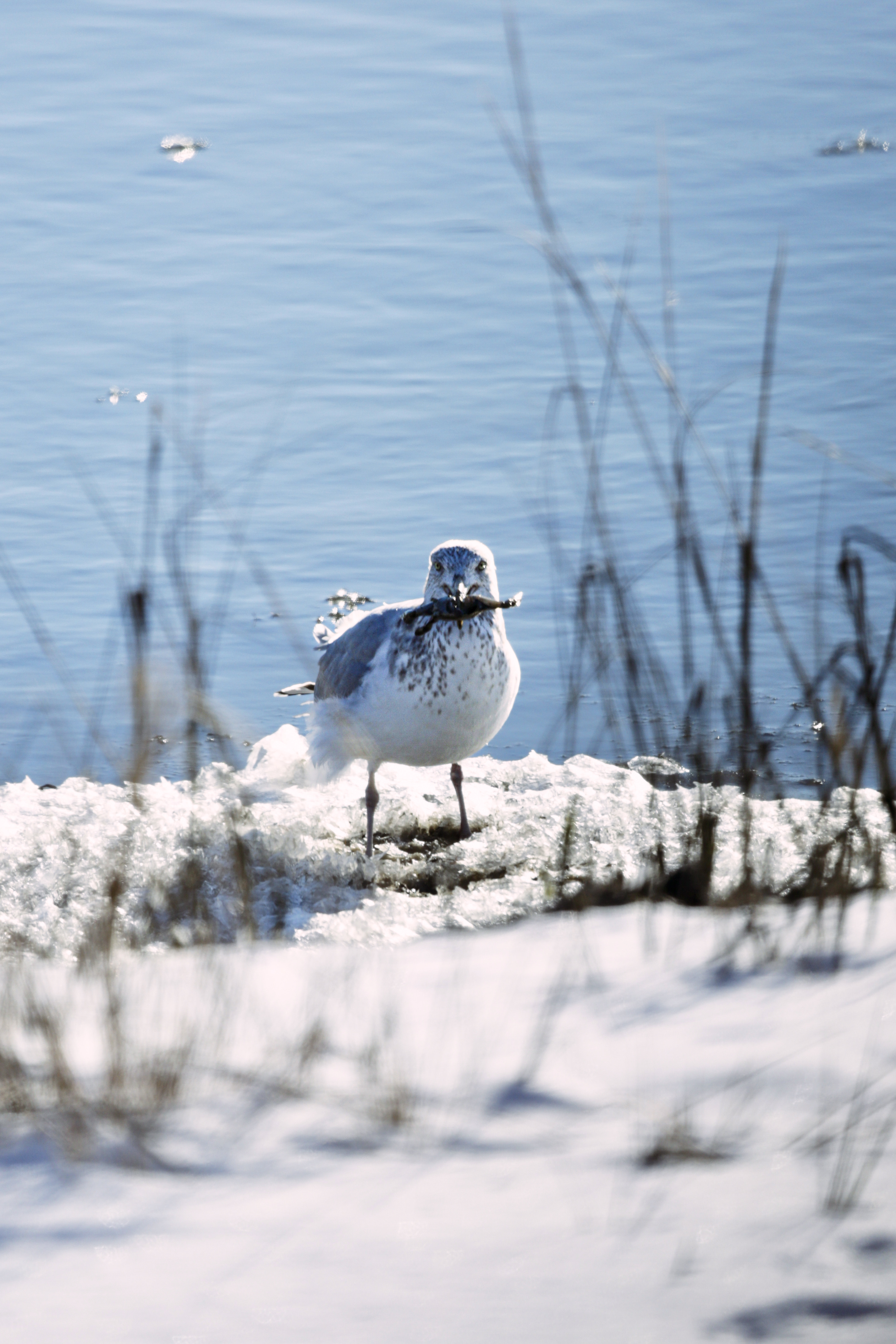
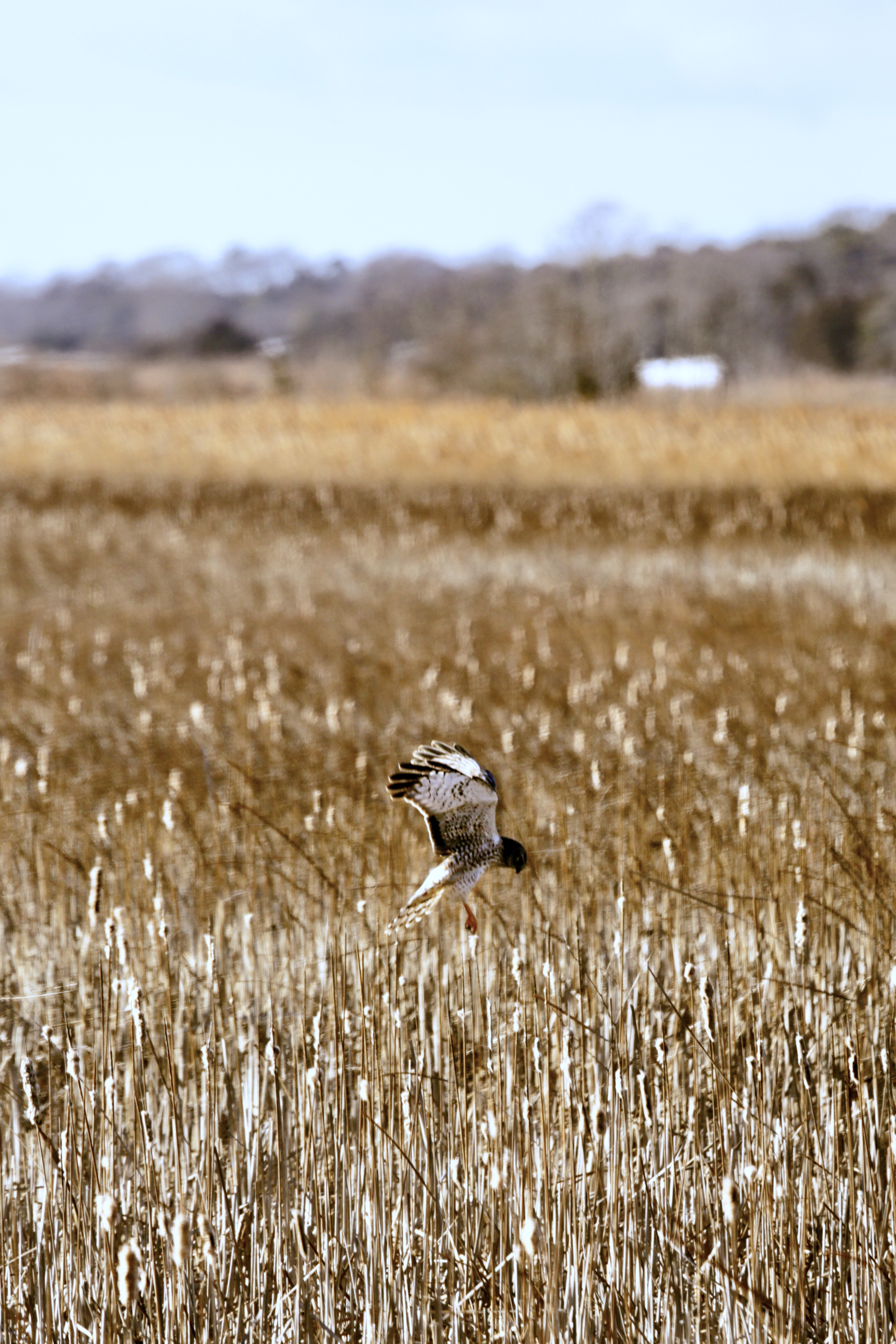
 Winter's Grip at Edwin B. Forsythe: Two Days After the Storm
On January 8th, the Edwin B. Forsythe National Wildlife Refuge was a scene of resilience and survival. A blanket of snow from the previous day’s storm transformed the landscape into a pristine winter tableau, while the icy bay mirrored the pale morning light. Normally a bustling destination filled with visitors, the refuge stood quiet, offering a rare glimpse into its unfiltered, wintry solitude—a sanctuary for both wildlife and those seeking its peace.
Sea gulls scoured the frozen shoreline, their sharp cries piercing the cold air as they unearthed crabs from beneath the ice. Above the snow-dusted marsh, harrier hawks glided silently, scanning for prey in an unforgiving environment. As the first rays of sunlight broke the horizon, a breathtaking moment unfolded—blue herons left their roosts in unison, their elegant forms silhouetted against the pale sky, driven by the primal need to hunt.
This delicate interplay between survival and beauty exemplifies the refuge’s essence. Even in the depths of winter, life persists here with a quiet determination. Each photograph captured tells a story of endurance, a testament to the indomitable spirit of wildlife amid nature’s challenges.
Winter's Grip at Edwin B. Forsythe: Two Days After the Storm
On January 8th, the Edwin B. Forsythe National Wildlife Refuge was a scene of resilience and survival. A blanket of snow from the previous day’s storm transformed the landscape into a pristine winter tableau, while the icy bay mirrored the pale morning light. Normally a bustling destination filled with visitors, the refuge stood quiet, offering a rare glimpse into its unfiltered, wintry solitude—a sanctuary for both wildlife and those seeking its peace.
Sea gulls scoured the frozen shoreline, their sharp cries piercing the cold air as they unearthed crabs from beneath the ice. Above the snow-dusted marsh, harrier hawks glided silently, scanning for prey in an unforgiving environment. As the first rays of sunlight broke the horizon, a breathtaking moment unfolded—blue herons left their roosts in unison, their elegant forms silhouetted against the pale sky, driven by the primal need to hunt.
This delicate interplay between survival and beauty exemplifies the refuge’s essence. Even in the depths of winter, life persists here with a quiet determination. Each photograph captured tells a story of endurance, a testament to the indomitable spirit of wildlife amid nature’s challenges.
December 31, 2024
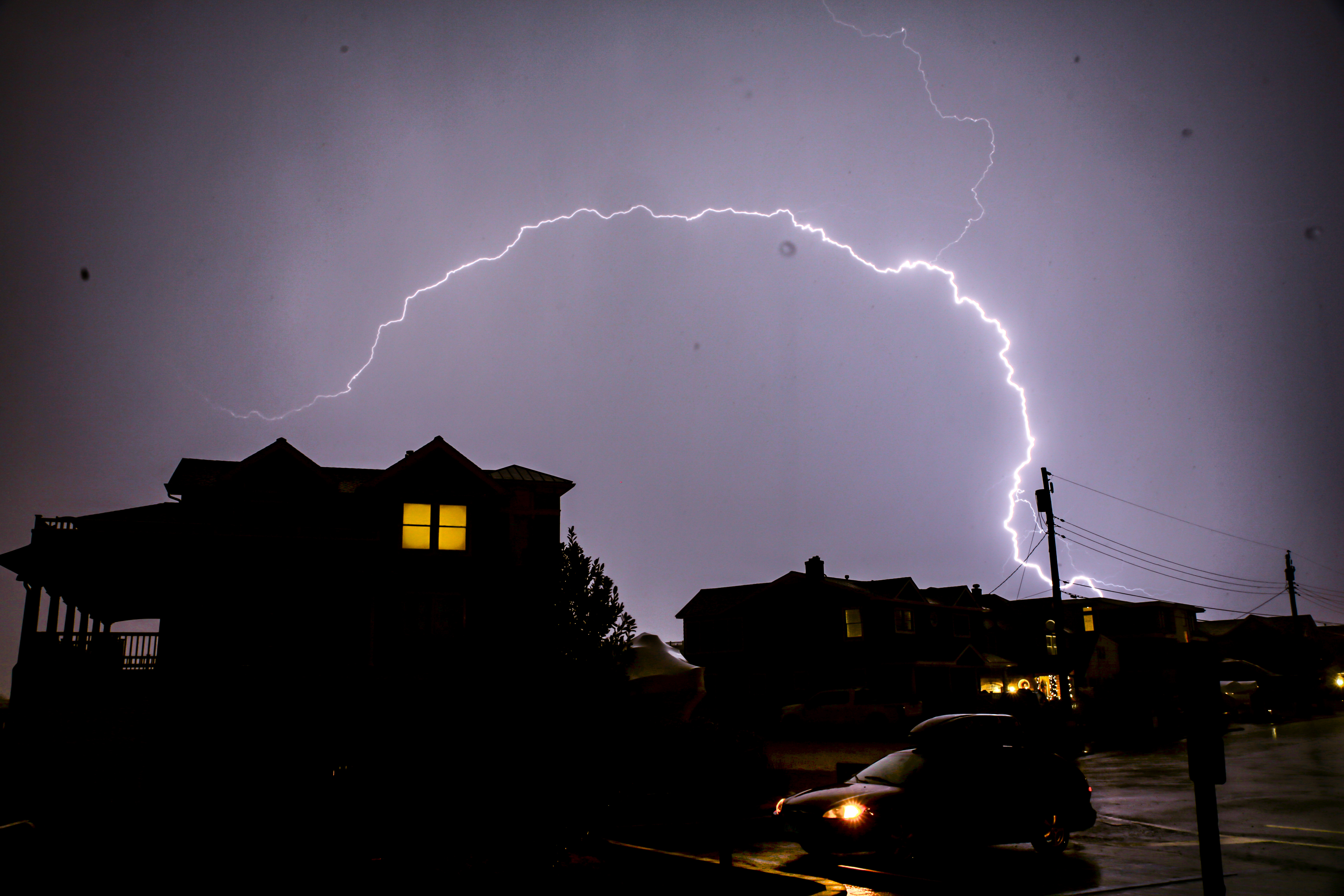
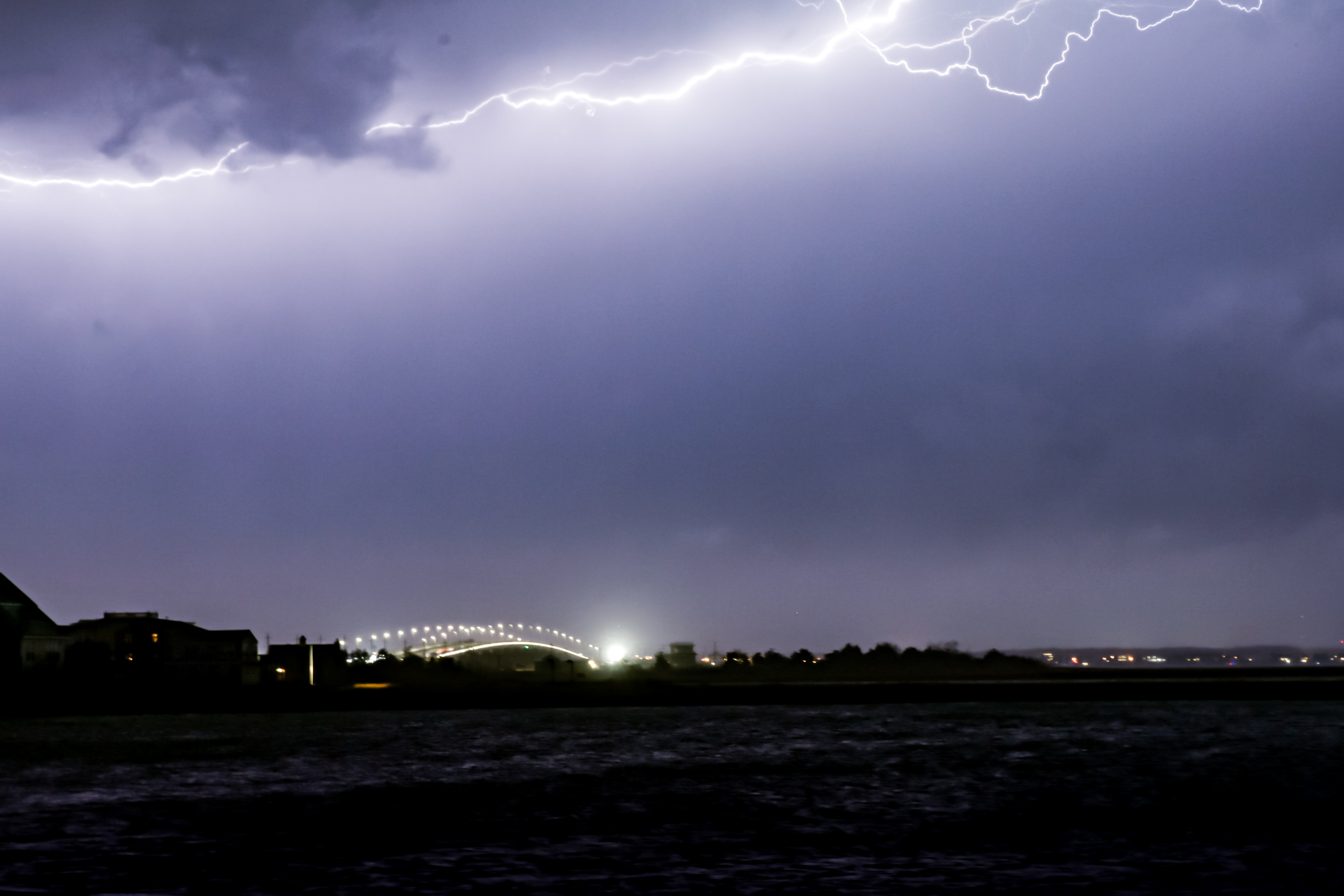
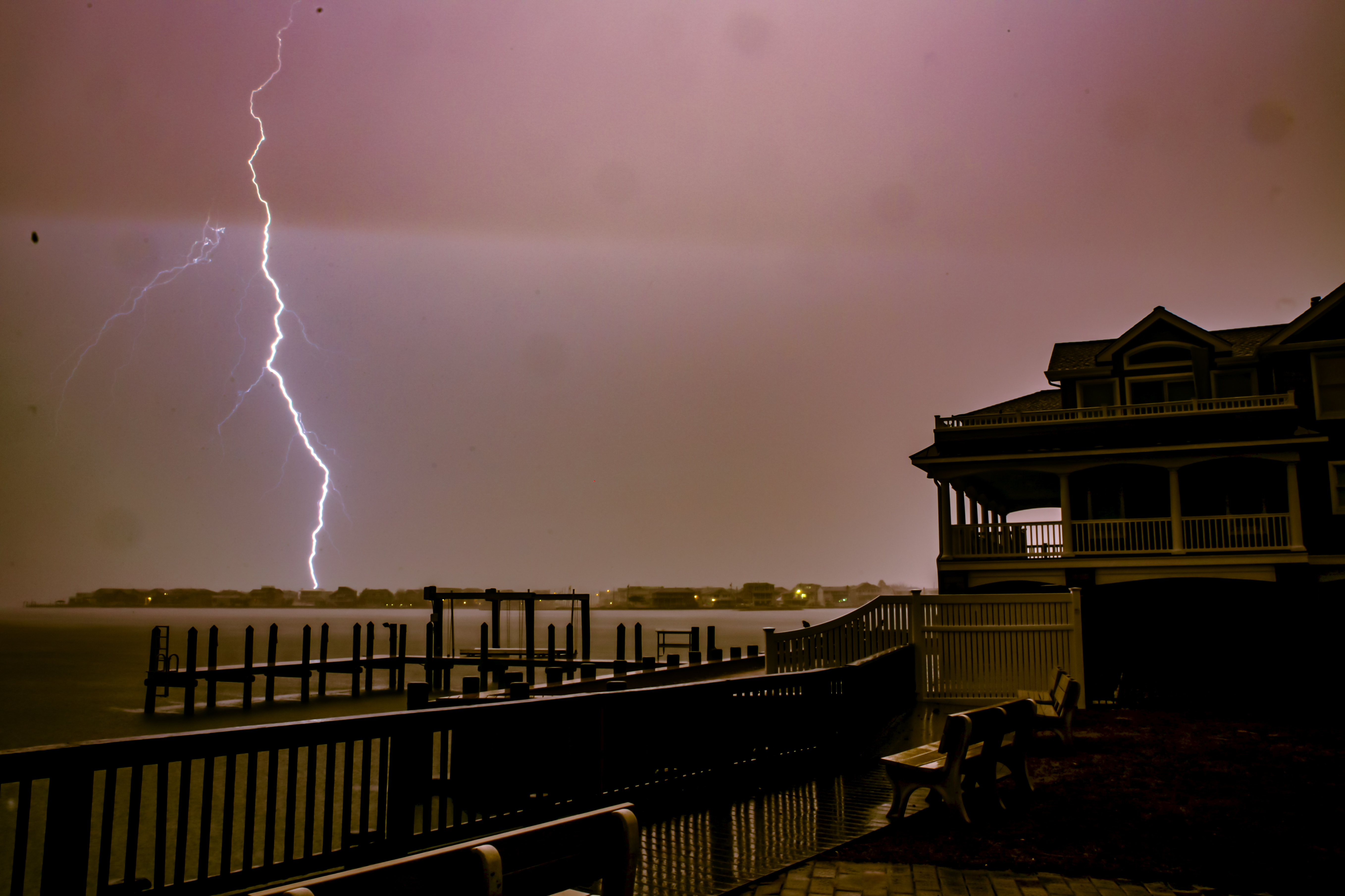 A Thunderous Farewell to 2024: Lightning on Long Beach Island
New Year’s Eve 2024 on Long Beach Island was anything but typical. As I approached the island, bolts of lightning split the night sky, illuminating the horizon with an electrifying intensity. The storm was relentless, a dazzling yet ferocious display that brought the year to a dramatic close.
Seeking shelter, I stood under a gazebo adorned with a lit Christmas tree, the warm glow of its lights a stark contrast to the chaos surrounding me. Lightning cracked with astonishing power, striking all around, bathing the landscape in blinding flashes. Each rumble of thunder reverberated through the night, a visceral reminder of nature’s raw strength.
Despite the protection of the gazebo, I was soaked from the waist down, drenched by the driving rain that seemed to come from all directions. Capturing the storm through my lens was exhilarating, but as the floodwaters began to rise, the intensity shifted from awe to urgency. Driving away, my car nearly succumbed to the rising water, making the escape almost as dramatic as the storm itself.
This New Year’s Eve wasn’t marked by fireworks or champagne—it was defined by a storm of unparalleled power. The experience left me drenched, humbled, and with unforgettable images to start the new year.
A Thunderous Farewell to 2024: Lightning on Long Beach Island
New Year’s Eve 2024 on Long Beach Island was anything but typical. As I approached the island, bolts of lightning split the night sky, illuminating the horizon with an electrifying intensity. The storm was relentless, a dazzling yet ferocious display that brought the year to a dramatic close.
Seeking shelter, I stood under a gazebo adorned with a lit Christmas tree, the warm glow of its lights a stark contrast to the chaos surrounding me. Lightning cracked with astonishing power, striking all around, bathing the landscape in blinding flashes. Each rumble of thunder reverberated through the night, a visceral reminder of nature’s raw strength.
Despite the protection of the gazebo, I was soaked from the waist down, drenched by the driving rain that seemed to come from all directions. Capturing the storm through my lens was exhilarating, but as the floodwaters began to rise, the intensity shifted from awe to urgency. Driving away, my car nearly succumbed to the rising water, making the escape almost as dramatic as the storm itself.
This New Year’s Eve wasn’t marked by fireworks or champagne—it was defined by a storm of unparalleled power. The experience left me drenched, humbled, and with unforgettable images to start the new year.